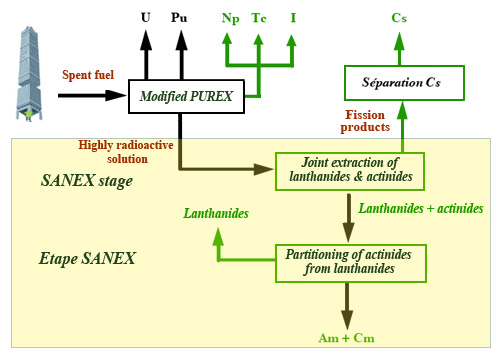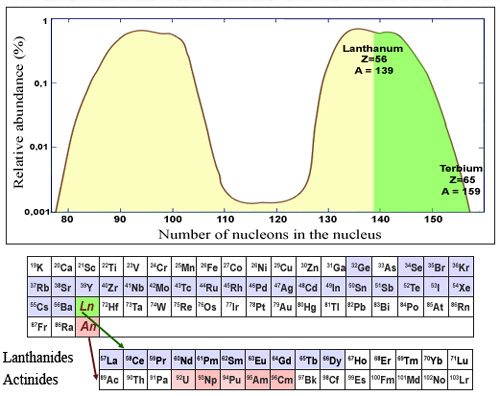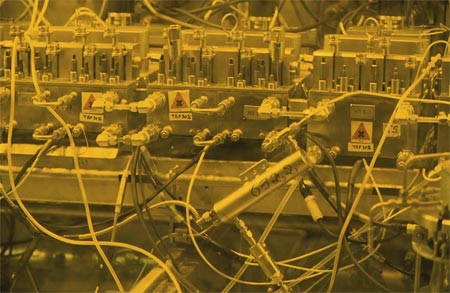Partitioning of nuclear waste: hot chemistry

Lanthanides versus actinides
The heaviest fission fragments belong to the lanthanide family (shown in green on the above oabundance graph). In the periodic table, the lanthanides are elements with similar chemical properties (the family begins at lanthanum and ends at lutetium). The lanthanides also have very similar chemical properties to a second family present in spent fuels, the actinides uranium and plutonium, but also minor actinides, neptunium, americium and curium. Partitioning the minor actinides from the lanthanides is therefore difficult.
© IN2P3
Advanced partitioning goes beyond just the partitioning of uranium and plutonium, which has been done industrially for the last 40 years using the PUREX process. This kind of partitioning is part of radiochemistry, a branch of chemistry that deals with the processing of highly radioactive materials and requires enhanced radiation protection. Hot chemistry, which is expensive and difficult, is justified if it leads to substantial benefits as regards waste management. Because of its cost, this difficult research could not have been undertaken without deliberate action by the public authorities. France has been lucky enough to benefit from this.
The radioactive elements for which advanced partitioning is currently being developed are three fission products, iodine, technetium and caesium, and three minor actinides, neptunium, americium and curium, so named because they are present in small quantities.
The early research was very basic because little was known about the chemistry of the actinides. The physical and chemical properties of the elements concerned had to be identified, and methods for extracting them from highly radioactive solutions had to be found.
The applied research phase followed on from demonstrations of the principle of advanced partitioning; the processes were tested on real fuels and demonstration tests were carried out almost at full scale. Large facilities like ATALANTE in Marcoule have made it possible to define the technical processes for partitioning, and demonstrate their technical feasibility.

Difficult process of partitioning minor actinides
Partitioning the actinides would have to be done in several stages. Extracting neptunium (Np) would require only the adaptation of the PUREX industrial process. Meanwhile, americium (Am) and curium (Cm) would first need to be partitioned jointly with the fission products classed as lanthanides (DIAMEX process). The next stage (SANEX process) would be to extract these minor actinides from the lanthanides, which are 50 times more abundant, and then to separate the americium from the curium.
© CEA (Source: Clefs CEA N53/Dominique Boullis)
The main objective of the research is the partitioning of the minor actinides. The partitioning of neptunium could be achieved by making minor changes to the PUREX process. However, neptunium is the most abundant but least radioactive of the minor actinides, and it is not the one that poses the most problems in the long-term management of waste.
The focus is therefore on the partitioning of the two remaining actinides, americium and curium. The extreme chemical diversity of the fission products present in the solutions to be processed also causes difficulties. Some, from the lanthanides family, have very similar chemical properties to the actinides but are up to 50 times more abundant. The preferred option at present is to work in two stages, partitioning the minor actinides and lanthanides from the other fission products first (the DIAMEX process), and then partitioning the americium and curium from the lanthanides under appropriate chemical conditions (the SANEX process).

Atalante: mixers and settlers
The ‘shielded process line’ at the ATALANTE facility began a series of experiments in 2004 to demonstrate the technical feasibility of advanced partitioning of minor actinides. To do this, the facility was given 15 kg of irradiated fuel. First the uranium and plutonium were partitioned and recovered separately, then lanthanides and minor actinides were removed, and finally the americium and curium. One can see above an array of mixer-settlers using extractant molecules for the extractions.
©P.Stroppa/CEA
Research into partitioning is run in France by CEA within the framework of Area 1 of the Bataille Act. The CNRS and the universities are also actively involved in it through the PARIS (‘Physico-chimie des Actinides et des Radioéléments en Interface et Solution‘) programme. At European level, partitioning research is grouped under the EU research and development framework programmes (FPs) through the Newpart, Partnew, Europart, Calixpart, Pyrorep and ACTINET networks. Elsewhere in the world, all the other major nuclear powers – Japan (JNC-JAERI), Russia (IPC Moscow-MINATOM) and the US (Argonne National Laboratory) – are active in this field.
Other articles on the subject « Waste Outlooks »
Three research areas
Three complementary research areas The three research areas under the Bataille Act, later supplem[...]
Area 1: Partitioning
Sorting the radioelements in radioactive waste The separation, or partitioning, of the radioactiv[...]
Partitioning: results
Development of processes and extractant molecules The 2006 assessment of research into partitioni[...]
Area 1: Transmutation
Area 1: Transmuting or transforming radioactive atoms Transmutation is the second part of researc[...]
Transmutation facilities
Fast reactors and Accelerator Driven Systems (ADS) The neutron, which easily penetrates nuclei, i[...]
Transmutation prospects
A far away objective for Generation IV and 2040… At the time of the first tests on the tran[...]
Area 2: Disposal
Research into deep geological disposal Can the nuclear industry’s final waste, which we cur[...]
Area 3: Long Surface Storage
Research into long-term storage Research into long-term storage is the second research topic in a[...]
Long surface storage concepts
Long-term surface and subsurface storage Research into very long-term storage is a matter for the[...]
Area 3: Conditioning
Area 3: Research into conditioning The conditioning of high-level and intermediate-level waste is[...]